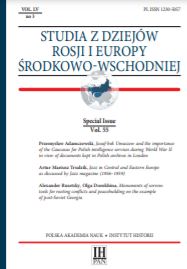In the Hallways of Versailles. “White” Russia and Poland during the Paris Peace Conference
In the Hallways of Versailles. “White” Russia and Poland during the Paris Peace Conference
Author(s): Mariusz WołosSubject(s): Diplomatic history, Political history, Pre-WW I & WW I (1900 -1919), Interwar Period (1920 - 1939)
Published by: Instytut Historii im. Tadeusza Manteuffla Polskiej Akademii Nauk
Keywords: International Relations 1918-1939; Paris Peace Conference; Polish–Russian Relations;
Summary/Abstract: The contacts that Poles and “White” Russians established in 1918 indicated that finding an agreement based on their common dislike of the Bolsheviks would be very difficult. The basic condition of the compromise emphasised by the Russians was the Polish agreement setting the future border separating their countries in accordance with the eastern border of the Kingdom of Poland, which, before the First World War, was part of the Russian Empire. The Russian side eventually agreed to slight deviations from this line. “White” Russia’s politicians and diplomats were interested in incorporating Eastern Galicia (together with Lviv) into their country, which they treated as “perennial Russian” land. Th us, many Poles living in Vilnius, Lviv and Eastern Galicia, as well as in the region around Białystok, would have had to remain outside of Poland if the Polish delegates had yielded to their “White” Russian colleagues, with whom they also had political differences. Until the end of World War I, “White” Russians had counted on the help of the Central Powers in overthrowing the Bolshevik regime. At the time, the Poles fought against Germany and Austria-Hungary, regardless of whether they were supporters of Józef Piłsudski or Roman Dmowski. During the Paris Peace Conference, the Polish delegation talked primarily to the representatives of the Russian Political Conference in Paris (in Russian: Русское политическое совещание в Париже), which brought together representatives of various anti-Bolshevik forces. The Russians were interested in forming “White” Russian troops in Poland to fight against the Red Army, which Poles treated with great caution, because they were afraid Warsaw would not have control over these troops. The Polish side was strongly opposed to the formation in Poland of units composed of former Russian prisoners of war in the Central Powers, fearing that they would move to the Bolshevik side. In general, politically and militarily supporting “White” Russia was not in line with the Polish raison d’état. In the case of a “White” Russian victory over the Bolsheviks, the future of the Polish border would be sealed, as the Entente powers would have likely supported their former ally and agreed to the eastern border of the former Kingdom of Poland. After all, the infamous Curzon Line was determined in December 1919 and extended in the south to the Carpathians without the knowledge and consent of the Poles in July 1920. It remains doubtful whether a Poland limited to the Curzon Line in the east and to the pre-war western border would have been able to remain a real political subject or to consolidate its existence altogether.
Journal: Studia z Dziejów Rosji i Europy Środkowo-Wschodniej
- Issue Year: 55/2020
- Issue No: Sp.
- Page Range: 5-32
- Page Count: 28
- Language: English

